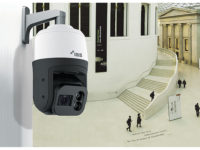As video surveillance continues its shift away from legacy analog systems to IP, there is a corresponding shift in the types of transmission equipment and technologies that are necessary. In other words, there are several different roads video can travel to get from “there” (the camera) to “here” (the head-end).
In the analog days, coaxial was the name of the game. And while coax is, at least to some extent, still relevant, it’s becoming less and less of a player in the transmission game. These days, it’s all about fiber, UTP (Cat5, Cat6, even Cat7) and more.
In addition to the analog/IP shift, there are wide varieties of additional variables that bear consideration in any installation. Is it a new installation or an upgrade from analog to IP? What distance is the video going to have to travel? How many cameras will be transmitting video simultaneously? These are just a few of the many questions to be asked before a proposal is even drafted.
“For dealers and integrators to succeed, they need to be flexible and identify the correct medium that is relevant to the specific customer and site that they’re involved with,” says Ami Amir, executive vice president of Ridgefield Park, N.J.-based DVTel.
Essential for any dealer or integrator who is installing video systems today is solid knowledge of networking technologies, standards and practices. Without that, says Jack Fernandes, president and CEO of American Fibertek, based in Somerset, N.J., you’ll not only be at a disadvantage compared to your competition, but you’ll also be doing a disservice to your customers.
“Understanding the speed, distance and bandwidth requirements of today’s sophisticated security networks requires a leap in understanding of complex integration of hardware, firmware and software. Only with this will they be able to recommend the best solution for their customer base,” he says.
So while there may be an ever-expanding menu of possibilities out there, proficiency with most, if not all, of the available transmission options is crucial to the success of any video system — and of the dealer or integrator who’s designing and installing it.
Decisions, Decisions
As Skip Haight, vice president of marketing for Danbury, Conn.-based Communications Networks (ComNet), puts it, everything depends on the ultimate goal of the system, which largely determines whether analog or IP is the right choice. If it’s analog, Haight says coax or UTP remain good choices for shorter distances, but for longer distances where EMI or RFI may cause a problem, optical fiber is the best choice.
When it comes to IP, however, that’s a little more tricky, he says. If you’re upgrading an analog system to IP, existing coax and twisted pair can be used to carry the video using distance-extending transmission devices, which will lower installation costs considerably. In a new installation, fiber-optic transmission is usually more cost-effective, and it provides greater bandwidth and distance capabilities than traditional copper, which Haight says is especially helpful with a large number of high-bandwidth (i.e. HD or megapixel) cameras.
In the “heyday” of analog CCTV, legacy VCRs and DVRs typically limited the number of cameras that could be attached to groups of eight, 16, 32, 64, etc., so designing a system was a fairly easy proposition, says Jeff Whitney, vice president of marketing, Intransa, located in Cupertino, Calif. That’s changed considerably today, as IP-based systems have become the most dominant, growing force in the industry.
“Today it is more difficult from the start to determine the number of cameras that can be supported by a video appliance or server, since HD and megapixel devices can dramatically impact the system’s computing and storage capacity,” Whitney says. “As a result, you often won’t find appliances or servers marketed by the manufacturers for a set number of cameras and the integrator must therefore use tools provided by the camera, VMS or server vendor to determine specific requirements.”
Steve Surfaro, security industry liaison, for Chelmsford, Mass.-based Axis Communications, says the most important consideration in choosing video transmission methods is determining how to deploy IP over virtually any infrastructure, which he says helps customers realize the ROI and low total cost of ownership that IP video provides. Ethernet over coax is the best example of this, he adds.
“End users are being asked to make tough decisions and work with less funding, and upgrades of legacy solutions are lower cost than the integrator or end user may realize,” Surfaro describes. “It isn’t all IP or nothing; there’s a migration option that will work for the integrator and end-user.”
Among the main factors to consider are location, application, environment, distance and reliability. But the greatest consideration may be costs — cabling, installation labor, future upgrades and more.
“Cost can be the deciding factor in some applications as well. If coaxial cable already exists at the same location where the new cameras will be installed, this can significantly decrease cable cost for the project,” says Jason Schimpf, director of partner relations, Arecont Vision, Glendale, Calif. “Ultimately, the integrator or project manager must consider all these factors to make the best choice for the application at hand.”
Shifting Landscape = Shifting Mindset
According to Haight, probably the biggest challenge dealers and integrators face is in shifting their knowledge and skillsets from analog to IP, which is by no means exclusive to video transmission. The difference in complexity between the two is just too great to ignore. “A traditional analog system is relatively easy. In many cases it’s as easy as plug and play,” he says. “But as you enter the Ethernet realm and when recommending an IP video system, on top of all the hardware recommendations, another set of challenges arises. You enter the world of switch programming, setting up VLANS, redundancy, MAC addresses, IP addresses and so much more.”
That kind of talk can be scary to a lot of installers who’ve been doing things the analog way throughout their careers, but Haight says it doesn’t have to be that way. “It’s a good plan to have access to a certified and trained network specialist as a resource to assist in overcoming any network setup challenges,” he advises.
Schimpf agrees. “For integrators and dealers who have been primarily promoting analog solutions in the past there is a daunting learning curve ahead,” he says. “However, failure to see the future and investing in the education and qualified manpower now will leave those that don’t behind as analog systems become obsolete.”
Failure to either gain the necessary IP know-how or partner with someone who can provide it can be devastating dealers’ and integrators’ businesses, says Jumbi Edulbehram, vice president of business development, Next Level Security Systems, Carlsbad, Calif. “IT integrators will take their traditional installation business if they don’t jump on the IP bandwagon,” he says.
Fernandes thinks the solution to this potential pitfall is reminiscent of the old real estate mantra, “Location, location, location.”
“Here it’s training, training and training. In a world where even your toaster has a memory chip, a good understanding of network technology is not just suggested but mandatory,” he says.
Surfaro singles out achieving reliability and video quality and video communications operability throughout the life of a system as the biggest challenge. “Working with camera and encoder products that offer the end user and integrator the most choice and flexibility by their strength of integration and partner network will extend the life of the system and allow the camera ‘platform’ to be built on,” Surfaro says. “Use of the most compliant IT-based products will enable the project deployment to be far smoother, with less hidden costs for all, and enable the best in scalability for future needs.”
In the opinion of Frank De Fina, senior vice president of sales and marketing for Ridgefield Park, N.J.-based Samsung Techwin America, the biggest challenge lies not with the technology, per se, but what he calls “marketecture” — that is, companies selling or in this case, overselling, those technologies. “Never believe the manufacturer’s cut sheet; always investigate for yourself,” he says. “Often the cut sheets will illustrate a feature or functionality that may not be fully functional. If you incorporate technology based on this ‘marketecture’ the possibility of failure will be ever present.”
And while overselling can be a big problem, Haight says it’s not limited to manufacturers. Often dealers and integrators miss their mark in recommending systems, he says, mainly because they either aren’t listening to or aren’t understanding their customers — meaning your ears are one of the most important tools in your kit.
“Recommending a high-end IP video system that can be viewed on a smartphone to the owner of a small convenience store might be great from a capabilities standpoint, but a few analog cameras, a video recorder and a monitor might meet the requirement and be more cost-effective and easier for the owner to utilize,” Haight says.
A Robust Highway
With HD and megapixel becoming more prevalent in installations, it’s important to ask what special considerations those high-resolution cameras require when determining transmission requirements. In any conversation about HD and megapixel, bandwidth is top of mind. As De Fina puts it, today’s high-resolution technology “needs to have a robust highway to run,” and that highway has to be wide enough to accommodate all the traffic it will face without hitting any snarls. “Along with that bandwidth comes a need to insure the highway it runs on is capable of sustaining and scaling additional devices as that network grows,” De Fina says.
So which technologies should be used for HD and megapixel video? “Any number of transmission systems can work, but the systems designer must do the math and consider the maximum possible bit rates that the system must handle,” Schimpf says. “While H.264 offers substantial improvement in average bit rate and storage consumption for megapixel, the bit rates are proportional to the resolution selected and subject to variation based on activity and lighting conditions.”
One workaround for this, Schimpf says, is to plan the total load of the system to be no more than 50 percent of the bit rate the transmission medium or network backbone can support. This allows wiggle room for times when throughput may spike. “Failure to consider this can result in lost packets, meaning dropped video frames or gaps, integration issues and other difficult-to-troubleshoot and difficult-to-resolve issues involving multiple vendors,” he says.
And there’s no time like the present to consider the ramifications of HD and megapixel video and determine whether a system will be able to handle the extra load, Whitney says.
“Ensuring that the design of the system will be able to meet the bandwidth requirements of HD/megapixel cameras for file size and bit rate is important right from the start,” he says. “Otherwise, it can be costly to re-engineer the system to meet the actual demands on the infrastructure and can lead to system failure at critical times.”
There may be many types of transmission to choose from for HD and megapixel video, but there is one “flavor” that nearly everyone agrees shouldn’t even be an afterthought.
“Avoid coax, since the analog signal gets degraded and the true quality you achieve is VGA-like and not HD. Use a good-quality HD H.264 camera and run it over IP,” says DVTel’s Amir.
Pros & Cons |
Coaxial CablePros: inexpensive, easy to install, easy to connect to, the de facto standard for legacy systems, can be used to transport Ethernet up to 5,000 feet, can support PoE Cons: distance limitations, prone to electromagnetic interference (EMI) and radio frequency interference (RFI), lightning strikes can impact the camera and the head-end, analog technologies being phased out
UTPPros: inexpensive, easy to install, easy to connect to, can transport Ethernet up to 1,800 feet with UTP extenders, newer Cat6/Cat7 cables ease future-proofing Cons: distance limitations, prone to EMI/RFI interference, lightning strikes impact the camera and the head-end, Cat5 rapidly becoming obsolete, Cat6 and Cat7 are expensive
Fiber OpticPros: greater transmission distance, supports larger bit rates, high bandwidth capacity, flexible, not limited to a specific signal type, resistant to EMI/RFI and lighting damage, eases future-proofing Cons: expensive (cable and other infrastructure components), requires skilled installers and specialized test equipment
WirelessPros: no cable to run or maintain Cons: less reliable than wired systems, prone to interference, requires either long-life batteries or dedicated power source, generally doesn’t support high bit rates, requires good line of sight
Compiled from sources interviewed for this story. |
HD-SDI |
|
One of the latest transmission technologies to arrive in the security industry is high-definition serial digital interface, known as HD-SDI. The technology, which comes out of the broadcast industry, uses the same coax cables with standard BNC connectors as analog systems, which can potentially allow for easier upgrades to legacy systems. At the moment, it’s not very widely deployed in video surveillance, says Intransa’s Jeff Whitney, but that’s not to say it doesn’t have a place in the industry. “This is a crossover technology from the broadcast industry, and will be useful in some hybrid analog/IP environments while the migration to full IP-based digital is underway,” he says. What makes HD-SDI attractive to the security industry, says American Fibertek’s Jack Fernandes, is that it doesn’t suffer from the latency issue that can plague HD and megapixel cameras today. That makes it an attractive technology in places like casinos where instant recognition is required. “It’s coming and will be a big part of CCTV,” he says. “Almost every Asian camera company is working on HD-SDI now, and prices are falling like a rock.” Of course, not everyone is sold on HD-SDI as the next big thing. “The only benefit is that it provides data rates of 3 gigabytes, which is useful for the transmission of uncompressed video in media applications, such as television stations. It’s not useful in surveillance,” says Jumbi Edulbehram of Next Level Security Systems. “It is not at all common and in my opinion, it is not headed anywhere.” So will HD-SDI have an impact on the security industry, and if so, how much of an impact? Only time will tell, so stay tuned. |







